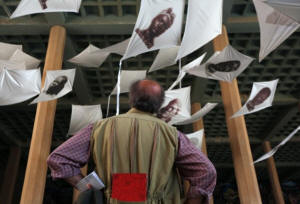|
At Dakar Biennale, Africa's artists urged
to seize chance
 Send a link to a friend
Send a link to a friend
 [May 10, 2018]
By Tim Cocks [May 10, 2018]
By Tim Cocks
DAKAR (Reuters) - Senegal's old Palais de
Justice sits among some of the most sought-after real estate in the
capital Dakar, where it shares a stunning sea view with the nearby
French ambassador's residence.
So, many Senegalese were surprised when 18 months ago President Macky
Sall turned the vast modernist building into a museum for fine arts -
rarely a priority for African leaders usually more preoccupied with
building roads and wooing hotels.
Now, at the latest installment of Africa's oldest and biggest biennale
art exhibition, the curator who lobbied for this space wants African
artists to seize the moment as the continent finally starts to enjoy the
attention it deserves.
"The global message for the African is, if we don't catch that train -
and the train is leaving now - too bad for us. Tomorrow will be too
late," curator Simon Njami told Reuters at the venue, where more than 75
artists from around the world are exhibiting their work for a month.
The practice of hosting art exhibitions every two years has spread to
several African countries, but none has been more successful so far than
the Dakar Biennale, founded in the 1990s and also known as Dak'Art.

This year's displays by African artists at the biennale are as eclectic
as those from elsewhere. They include works using materials that have
become hallmarks of the continent's modern art - such as the recycled
food packaging and strips of "African print" cloth in Nigerian artist
Olanrewaju Tejuoso's abstract wall piece.
Others - involving lights going on and off, rooms scattered with
everyday household objects or projectors beaming images with enigmatic
slogans onto walls - wouldn't look out of a place in a Western
conceptual art exhibition.
One by South African artist Frances Goodman seems to conjure up intense
rage using an amorphous blob of fake fingernails.
In the past quarter-century African art has gone from near total
obscurity on the world scene to producing stars such as Ghana's El
Anatsui and South Africa's William Kentridge.
"It's a whole continent that was ignored. The market is just starting to
pick up on it," said Njami, a Swiss national of Cameroonian descent.
"Before, anyone could have bought an El Anatsui. Nowadays if you don't
have $2 million, forget about it."
[to top of second column]
|

A man looks at "Triumph of Seagulls", by Nathalie MBA Bikoro during
the 13th edition of the Dakar Biennale of African Contemporary Art,
Dak'art in Dakar, Senegal May 4, 2018. REUTERS/Mikal McAllister

In March a portrait of a Nigerian princess that was lost for 40
years and found in London sold for $1.4 million.
Despite successfully lobbying for the Palais, Njami thinks African
governments do woefully little to support the arts.
"People say: 'Why spend money on arts when you can build a road?'"
he said. "But we need culture, not just infrastructure".
Owing to poor support, facilities and a tiny domestic market, many
of Africa's most talented artists predictably end up in Europe or
the United States. Those staying at home are often underresourced.
At the exhibition, Senegalese artist Badara Sarr complained that his
spot was underlit, so he had to buy a spot lamp, and then there was
no technician available to install it.
"It was a bit deplorable, but we manage as Senegalese. That's Africa
for you," he told Reuters next to his cloud-like patches of red,
blue and green paint. Despite being a bit in the dark, "a lot of
people are interested" in his painting.
"I'm honestly happy about the interactions we're having," he said.
(Editing by Mark Heinrich)
[© 2018 Thomson Reuters. All rights
reserved.]
Copyright 2018 Reuters. All rights reserved. This material may not be published,
broadcast, rewritten or redistributed.
Thompson Reuters is solely responsible for this content.
 |